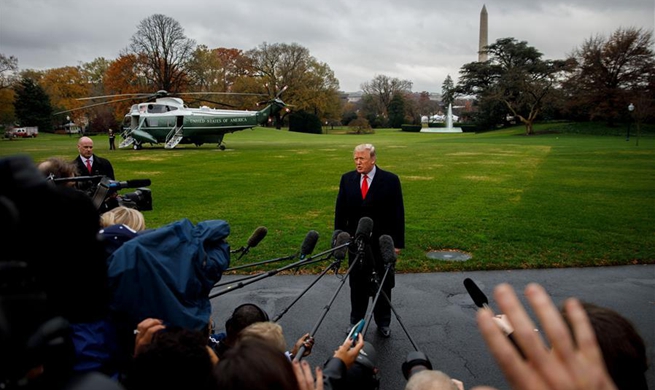WASHINGTON, Nov. 26 (Xinhua) -- While American consumers still went in large numbers to shop at physical malls during the Thanksgiving holiday, retailers saw a surge in online sales that blurred the demarcation line between Black Friday and Cyber Monday.
Initial data showed that total spending on Black Friday hit 23 billion U.S. dollars, up 9 percent year-over-year. A breakdown of specific data suggested that online sales are gaining an upper hand as sales at physical stores continued to drop, in keeping with the trend in recent years.
The Thanksgiving Day falls on the last Thursday of November in the United States, while the following Friday, commonly referred to as Black Friday, kicks off the traditional shopping season in a year as stores online and offline both offer attractive discounts.
The shopping weekend wraps up on the ensuing Monday dubbed Cyber Monday, on which online portals continue to sell items at low prices.
According to preliminary statistics by analytics firm RetailNext, net sales at brick-and-mortar stores fell 4 to 7 percent between Thanksgiving Day and Black Friday, while traffic fell 5 to 9 percent.
In 2017, brick-and-mortar sales were down 8.9 percent for the two days year-over-year, and shopper traffic fell 4.4 percent. In 2016, store sales fell 4.2 percent and traffic dove 4.4 percent, according to RetailNext.
Although the record-low temperature in the nation's northeast region this year might have discouraged store visits, RetailNext spokesperson Ray Hartjen said the slightly larger loss in store foot traffic was still within expectations.
Data from retail research firm ShopperTrak showed that visits to stores fell a combined 1 percent during Thanksgiving Day and Black Friday compared with the same period in 2017.
Last year, visits to physical stores on Thanksgiving Day and Black Friday were down 1.6 percent from the previous year, the firm said.
A noteworthy phenomenon this year around, however, was that more and more people opted for online shopping. Data compiled by Adobe Analytics indicated that digital sales reached a record-breaking 3.7 billion dollars on Thanksgiving Day, a nearly 28 percent rise from the previous year.
Furthermore, Adobe, which tracks e-commerce transactions across 80 of the top 100 U.S. online retailer, said that for the first time in 2018, Thanksgiving Day saw 1 billion dollars in sales from smartphones, driving 36.7 percent of all e-commerce sales and up 8 percent year-over-year.
Adobe said this year's Thanksgiving Day was expected to be the second-largest e-commerce day in U.S. history, behind Cyber Monday 2017, which brought in 6.6 billion dollars. Cyber Monday, on which online shopping sites offers big discounts attract buyers, falls on the Monday that immediately follow the Thanksgiving Thursday
On Black Friday, digital sales garnered 6.22 billion dollars in total, up 23 percent compared with the same day a year ago. Of that tally, smartphone-enabled purchases amounted to 2.1 billion dollars, constituting 33.5 percent of the overall daily sales. The proportion was 29 percent on the same day in 2017.
"Black Friday will come very close to eclipsing last year's Cyber Monday in terms of online sales," techcrunch.com cited Taylor Schreiner, director of Adobe Digital Insights, as saying.
This year's Cyber Monday is projected to bring in 7.8 billion dollars, according to Adobe's estimates.
Internet Retailer, another analytics group, forecast that U.S. shoppers will spend a record 21.6 billion dollars online between Thanksgiving Day and Cyber Monday, making up roughly 15 percent of a perceived 143.82 billion dollars in total when online and offline purchases are combined.
Based on Internet Retailer's assumptions, online sales are up 15.5 percent year-over-year, while total sales will grow 5.5 percent from the previous year. However, the group added that the additional rewards will not be shared evenly by the many retailers competing against one another, with Amazon believed to reap some one-third of the total sales.
In a device-specific perspective, Adobe's statistics found out that from Nov. 1 to 22, 2018, purchases made by desktops reached 21.6 billion dollars, or 60 percent of overall online sales, smartphone contributed 9.8 billion dollars, or 30 percent, and the remaining 10 percent was made by tablets, which brought in 3 billion dollars.
Traditionally, Black Friday is considered the start of the Thanksgiving holiday shopping season, but physical stores have constantly opened doors earlier in recent years to compete with online shopping portals. One of their strategies is the so called "buy-online-get-from-store" method of purchase. Orders of this category rose 73 percent this year.
Despite the growing popularity of online shopping vis-à-vis offline purchase, market insiders said e-commerce continued to account for 10 to 20 percent of overall sales, much in line with what it did in the past. That means a structural change in American shopping habits has yet to occur for the time being.












